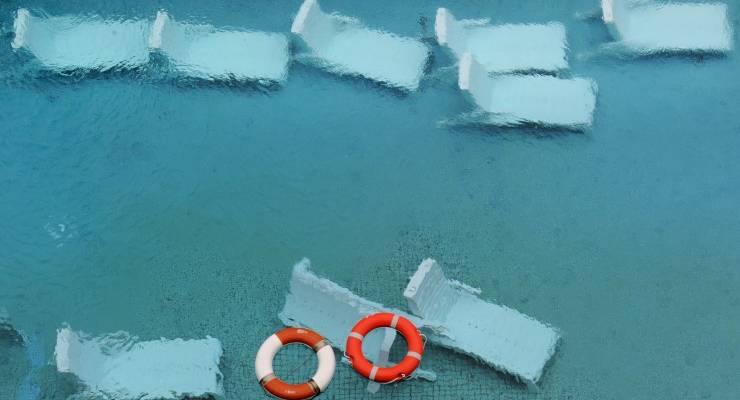
Beautiful one day, seaborne the next
Hey, do you enjoy Cairns? Sure you do! It’s a beautiful part of the world, surrounded by natural splendour and boasting a nice, flat, low-lying aspect just above sea level which is absolutely perfect for welcoming tourists, holidaymakers and catastrophic storm surges which would flood the CBD, hospital and airport.
This isn’t exactly new information, since Cairns has been around for a while and had plenty of storms (including a near-miss in 2011 from Cyclone Yasi which still knocked them around plenty). But now James Cook University associate professor Dr Jonathan Knott has warned that Cairns is right in the sweet spot for the new and stronger cyclones set to be crated by the current La Nina phase of the southern oscillation climate pattern.
“Yasi created a 7.5-metre storm surge,” he perkily told InQueensland. “If the equivalent of Yasi crossed halfway between Cairns and Port Douglas, we would see a seven-metre storm surge coming into Cairns. That’s water going through at least the second floor of the Cairns Hospital.”
Fortunately, the region’s MP Warren Entsch isn’t fussed about such alarmist tosh, claiming it might just mean they get a “normal” wet season. And that’d be nice, provided that “wet” doesn’t mean “scattered through the Coral Sea”.
Oh, and just to make clear that climate-induced weather panic is a global thing, the northern hemisphere hurricane season started nice and early this year. In fact, it’s now celebrating its 25th storm — Hurricane Delta, which is currently moving uncomfortably close to the US Gulf Coast and Mexico’s Yucatan Peninsula — about six weeks earlier than would be usual.
So things are great all over, is what we’re saying.
Who watches the rortsmen?
You’ve no doubt inhaled all of Crikey’s exhaustive budget content and might reasonably think that you’ve got a pretty good handle on the razzle and dazzle of federal economics’ glorious night of nights, when the brightest stars of Treasury come out to shine.
But like so many big franchises, much of the most interesting stuff came out in the fan-only supplemental material, including a twist where the Morrison government took aim against one of its most hated foes: the Australian National Audit Office (ANAO).
You might know the ANAO as the ivory-tower, pencil-pushing do-gooders who made life so difficult for the government over the whole “sports rorts” thing, just because they apparently had some sort of problem with a government deploying millions of dollars of public money as pre-election sweeteners in strategic electorates despite having absolutely no moral or legal authority to do so. Killjoys!
They were also the folks who wondered why a parcel of land owned by billionaire Liberal donors and valued at $3 million was bought by the government for almost $30 million, forcing then-urban infrastructure minister Paul Fletcher to explain to the auditor-general that gentlemen don’t have grubby conversations over petty things like paying 10 times what some land is worth. After all, that would be gauche!
Or you might remember the ANAO from a few weeks ago when it explained that their budget was insufficient for the level of scrutiny it was obliged to give the spending of government funds and that it would need a funding increase in order to do their job.
And the Morrison government has reached out to help the ANAO with a top up of… minus $14 million, decreasing their annual budget from $112 million to $98 million.
Whether the departmental budget announcement was delivered via a severed animal head in the auditor-general’s bed could not be confirmed at press time.
Don’t think of the children
While everyone was losing their mind over Trump’s shock COVID-19 news last Friday, the news broke that the South Australian government had quietly stopped funding the Infant Therapeutic Reunification Service — a service which focussed on working with at-risk children and families by giving them support to keep parents and kids together — and have replaced it with… nothing.
The interdisciplinary service works — sorry, worked — with traumatised children and families to help overcome the problems which would otherwise necessitate the removal of children for their own safety. Which, while necessary in certain cases, is in itself a traumatic experience for everyone involved.
It’s an understandably sensitive area where complex issues of child welfare, poverty, mental and physical heath, trauma, housing, the justice system and access to services all collide, so the fact it reportedly boasted an 82% success rate in keeping families together was downright remarkable. Mind you, that might explain why it won an award for excellence in assessment and/or treatment at the 2016 Mental Health Service Awards.
It also reduced pressure on the Department for Child Protection, which made the Marshall government’s decision to defund it all the more surprising — although a statement from the government countered that it was only a pilot programme intended to last for five years, that the level of funding for the sector has not decreased, and that it’ll be putting together a tender for a private sector organisation to take over the role later this year.
That said, according to the South Australian Salaried Medical Officers Association there’s a question mark over whether anyone would even bid for it since it’s a very specific area in which all of the current expertise is in the public system.
You wouldn’t think that the welfare of children and the wellbeing of families was necessarily an area that could just wait for a tendering process to play out in the hopes of being run on the cheap, or not at all, but here we are.








They must have thought ANAO was a typo and it was really the ABC.
Did Angus have anything to do with it?
We don’t need “climate-induced weather panic”. Stampeding the sheep might be fun for the scaremongers, but it is quite destructive. Inaction-induced anger would be more productive.
Why not, Roger? People have been sleep walking into a climate catastrophe. This year’s La Niña might just be the one that wakes a few people up, especially those coal loving nth Queenslanders. Matt Canavan surely has a great plan for it all – just keep digging.
I think we exactly need some climate induced weather panic. What was that town that Tony Abbott thought would be wiped out by the carbon tax, was it Whyalla? I’m thinking Cairns might just be our first climate induced ghost town – with no reef to visit and underwater for months in a year. It’s very possible. We should be panicking now, that’s all that ScoMo will listen to.
Under the “flim,flam”man and his less than ethical cohorts we are seeing the gradual destruction of democracy as we have known it. Not content with stacking the regulatory bodies with their mates they are now defunding public service bodies that cause them embarrassment,when their dodgy actions are brought to light.
It’s not gradual.
Stoked that ANAO’s chocolate ration has been increased …
De-funding ANAO is a particularly egregious bit of LNP shafting. This says much about Morrison, the public service is there to serve the government, in his view, not the public.
No federal ICAC, and a reduced funded ANAO. He doesn’t like this accountability thing, our ScoMo.